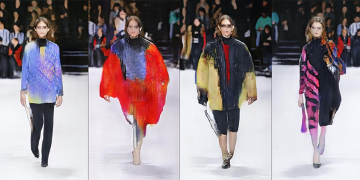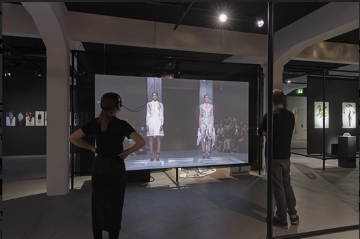The conversation was realized as part of Dr. Nadzeya Sabatini‘s course Conversations with Industry Experts offered by USI – Università della Svizzera italiana and Université Paris 1 Panthéon-Sorbonne’s Master Program in Digital Fashion Communication.
The article was written by Giorgia Antolini, Francesca Mennillo, Felicitas Thieme, Luna Van de Walle – Master’s students in Digital Fashion Communication, Ylenia Gervasoni and Francesca Gianini – Master’s students in International Tourism, and edited by Alice Noris – PhD student and Teaching Assistant.

Fashion and technology go hand in hand. What once was seen as purely craftsmanship and art is now increasingly overlapping with technological progress, which puts fashion in a completely new context. From social media and technical drawings with Adobe software, to 3D modeling of clothing and textiles with programs such as CLO3 and Blender, to future innovations in the fashion world as digital fashion expositions, digital twins and so on; technology is already deeply rooted in fashion. We had the pleasure to discuss the fusion of these two topics in another session of our Conversations with Industry Experts class.
As part of our course we had the opportunity to meet and talk with Katharina Sand, a writer, lecturer, curator and entrepreneur. Katharina first entered the fashion industry in New York, writing for various important media and making her way into the field, opening her own high-end fashion boutique in Geneva: Septieme Etage, as well as becoming a speaker and lecturer. Recently, she curated the exhibition “Making FASHION Sense”, showcasing the radical transformation of fashion through technology and joined our faculty at USI as a PhD candidate. The conversation with her, being an expert in the combination of fashion with technology gave us a great insight in what the potential future of fashion might look like. Katharina believes that the future fashion industry could be divided into three markets: first, the mass market, luxury storytelling, secondly the creative young designers, both engaging in virtual fashion, and lastly actual clothes that we wear while engaging with this content. “Obviously we are wearing things”, she explained during the interview, “Physical fashion will never disappear, we need to get dressed every day, during these times, for example, we pay particular attention to comfortable clothing while working from home.”
Furthermore, she hopes that technology won’t lead to a lack of artistic value but contrarily, that it will enable “fantastic and engaging creativity that normally wouldn’t have been possible”. This new trend of virtual clothing has the advantage of enabling what would have been impossible to wear or produce in the past, as well as reducing waste and thus being an added value for the sustainable development of the industry.
Not only the garments are going digital but the whole fashion industry is. In fact, Katharina is currently working on a fashion related online exhibition. In times of lockdown this is a very interesting project and might be a future addition to the physical way of entering a museum or gallery.

During her academic research on the topic she discovered that people still fear in choosing digital over physical. Curators and organizers of exhibitions have often tended to use digital tools only in terms of helping people in getting into the museums, rather than using them as a form of entertainment and experience. Katharina thinks this is not the appropriate approach: “I think you can’t start from a point of being scared. If people are embracing digital technologies, you have to go for it and figure out how you can connect it or apply it in the physical space”. Digitalization can create multiple opportunities to entertain people and make them experience culture in new ways.
Another component of the fashion industry that Katharina believes will be influenced by digital technologies are fashion shows. She has been observing them since 1995 and she has been very fascinated by how they have completely changed over the last years. She thinks that the next generation should be able to create virtual fashion shows and learn all the tools to be able to do this, because it is definitely going to be a major part of the future. “I do think that there will still be very exclusive small groups fashion shows for the very high-end haute couture community”, she said, “However, I do think that most of the other fashion shows will become virtual.”
Being open-minded, spontaneous and take chances as they occur are some of the main takeaways from this interview. Saying yes to people and opportunities is what she calls one of her career secrets, a door opener that allowed her to start her career in fashion, to become a fashion retailer and the person she is today.
Other Educational Sources individuated by the students for further readings on the topics presented during the conversation with Katharina Sand:
- How Data is Driving the Future of Fashion – A Ted Talk by Steve Brown, where he explains how data and technology are affecting the fashion industry and where he illustrates how he sees the future of the fashion field.
- Look and feel good: How tech could save the fashion industry – A CNN Business article byNell Lewis and Max Burnell about how technologies are impacting the ways in which clothes are currently produced and about how they help to make the fashion industry more sustainable in the long run.
- YouTube’s First Virtual Fashion Show/ CR Runway with amfAR against Covid-19/ Fashion Unites #WithMe – The first virtual runway on YouTube. This initiative has been created by Carine Roitfeld to raise money for organizations that are fighting Covid-19. The runway was realized through a collaboration between CR Runway and amfAR in collaboration with top models from all around the world working from home.
- Fashion brands embrace 3D design – An article from Vogue Business that explains how 3D technologies are affecting the fashion industry, especially now during the Covid-19 crisis.
11.05.2020